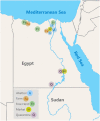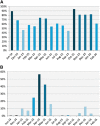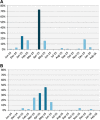Systematic, active surveillance for Middle East respiratory syndrome coronavirus in camels in Egypt
- PMID: 28050021
- PMCID: PMC5285495
- DOI: 10.1038/emi.2016.130
Systematic, active surveillance for Middle East respiratory syndrome coronavirus in camels in Egypt
Abstract
Middle East respiratory syndrome coronavirus (MERS-CoV) causes severe human infections and dromedary camels are considered an intermediary host. The dynamics of natural infection in camels are not well understood. Through systematic surveillance in Egypt, nasal, rectal, milk, urine and serum samples were collected from camels between June 2014 and February 2016. Locations included quarantines, markets, abattoirs, free-roaming herds and farmed breeding herds. The overall seroprevalence was 71% and RNA detection rate was 15%. Imported camels had higher seroprevalence (90% vs 61%) and higher RT-PCR detection rates (21% vs 12%) than locally raised camels. Juveniles had lower seroprevalence than adults (37% vs 82%) but similar RT-PCR detection rates (16% vs 15%). An outbreak in a breeding herd, showed that antibodies rapidly wane, that camels become re-infected, and that outbreaks in a herd are sustained for an extended time. Maternal antibodies titers were very low in calves regardless of the antibody titers of the mothers. Our results support the hypothesis that camels are a reservoir for MERS-CoV and that camel trade is an important route of introducing the virus into importing countries. Findings related to waning antibodies and re-infection have implications for camel vaccine development, disease management and zoonotic threat.
Figures






Comment in
-
Reply to Ringlander et al.J Infect Dis. 2021 Jun 4;223(11):2014. doi: 10.1093/infdis/jiaa628. J Infect Dis. 2021. PMID: 33037879 No abstract available.
References
-
- Zaki AM, van Boheemen S, Bestebroer TM, Osterhaus AD, Fouchier RA. Isolation of a novel coronavirus from a man with pneumonia in Saudi Arabia. N Engl J Med 2012; 367: 1814–1820. - PubMed
-
- World Health Organization. Middle East respiratory syndrome coronavirus (MERS-CoV). Geneva, Switzerland: WHO; 2016. Available at http://www.who.int/emergencies/mers-cov/en/ (accessed on 15 November 2016).
-
- World Health Organization. Middle East respiratory syndrome coronavirus (MERS-CoV): summary of current situation, literature update and risk assessment. Geneva, Switzerland: WHO; 2015. Available at http://apps.who.int/iris/bitstream/10665/179184/2/WHO_MERS_RA_15.1_eng.p... (accessed on 15 November 2016).
-
- Bermingham A, Chand MA, Brown CS et al. Severe respiratory illness caused by a novel coronavirus, in a patient transferred to the United Kingdom from the Middle East. Euro Surveill 2012; 17: 20290. - PubMed
MeSH terms
Substances
Grants and funding
LinkOut - more resources
Full Text Sources
Other Literature Sources
